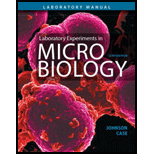
During a 3-month period, acute hepatitis B virus (HBV) infection was diagnosed in 9 residents of a nursing home. Serological testing of all residents revealed that 9 people had acute HBV infection, 2 had chronic infection, 5 had antibodies to HBV, and 58 were susceptible. Medical charts of residents were reviewed for history of medications and use of ancillary medical services. Infection control practices at the nursing home were assessed through interviews with personnel and direct observations of nursing procedures. A summary of the medical charts is shown below.

*A case patient has hepatitis B.
Susceptible residents live in the nursing home but do not have hepatitis B.
- What is the usual method of transmission for hepatitis B?
- What is the probable source of infection in hospitals?
- How was this infection transmitted?
Want to see the full answer?
Check out a sample textbook solution
Chapter 39 Solutions
Pearson eText for Laboratory Experiments in Microbiology -- Instant Access (Pearson+)
- A cell expresses a transmembrane protein that is cleaved at the plasma membrane to release an extracellular fragment. The fragment binds to receptor proteins on nearby cells and activates signaling pathways resulting in altered gene expression patterns in the cells. What form of intercellular signaling does this represent? OA. Contact-dependent signaling B. Paracrine signaling OC. Synaptic signaling D. Endocrine signaling E. Autocrine signalingarrow_forwardWhich of the following drive nuclearly encoded proteins import into the mitochondrial matrix? OA. ATP hydrolysis OB. Membrane Potential OC. K+ Ions OD. A and B OE. None of the abovearrow_forwardWhich of the following statements is true regarding Cholesterol import into the cell? OA. It is transported within LDL B. Receptor mediated endocytosis is involved OC. Release of cholesterol occurs in the Lysosome D. All of the above are true statements OE. None of the above are true statementsarrow_forward
- In which of the following schematic drawings of signaling pathways does the activation of the receptor lead to gene expression? Activating and inhibitory steps are indicated with (+) and (-), respectively. OA OB ㅇㅂㅇㅂㅇㅁ (+) Gene Expression Activated Signaling proteins Transcription receptor activator Bl D Gene Expression Gene Expression ㅁㅁㅇ Gene Expression Gene Expressionarrow_forwardWhich of the following events normally activates a GTP-binding protein? OA. GTP hydrolysis by the protein OB. Activation of an upstream GTPase-activating protein OC. Activation of an upstream guanine nucleotide exchange factor OD. Phosphorylation of a bound GDP molecule by an upstream phosphorylase OE. Pi release after GTP hydrolysisarrow_forwardProteins that are synthesized on the Rough ER are imported into the ER lumen after their signal sequence is recognized. Which of the following is responsible for the signal recognition? OA. Signal Recognition Particle, OB. Signal Sequence C. Stop-transfer sequence OD. Both B and C OE. None of the abovearrow_forward
- Stroma Light 4 H 4 H I Thylakoid- membran 2 H₂O D1 D2 Min Light 2,6 ATP 2 NADP+ 2 NADPH/H+ Fp 2,6 ADP +2,6 P 8 H+ 12 H+ 4 H+ Lumen PS II Cyt bef PS I ATP-Synthase 12345 5a 5b 6arrow_forwardWhich of the following statements is TRUE regarding the signal recognition particle (SRP)? OA. SRP is made up of RNA and Proteins B. SRP binds to the signal sequence OC. SRP binds to the elongation factor binding site on the ribosome and pauses translation D. All of the above are true statements OE. None of the above are true statementsarrow_forwardWhich of the following pathways does NOT directly deliver materials to lysosomes? OA. Endocytosis B. Exocytosis OC. Phagocytosis OD. Autophagy OE. Macropinocytosisarrow_forward
- You suspect a protein to be secreted out of a cell. What experiment would you perform to follow the movement of this protein through the secretory pathway? A. Pulse - Chase Experiment OB. Signal Sequence Deletion C. Signal Sequence Mutation OD. All of the above E. None of the abovearrow_forwardA schematic drawing of the secretory and endocytic pathways is presented below. Indicate which component in the drawing (A to J) corresponds to each of the following. Your answer would be a 10-letter string composed of letters A to J only, c.g. HICDJABFGE. nuclear envelope Early endosome Late endosome ER Lysosome A ( ) cis Golgi cisterna () modial Golgi cisterna () trans Golgi cisterna [] cis Golgi network (CGN) () trans Golgi network (TGN) () Secretory Vesicle B C D E CYTOSOL F G H plasma membranearrow_forwardWhich of the following guide transport vesicles to their target membrane? A. Rab monomeric GTPases B. Signal Sequence OC. Heat Shock Proteins OD. All of the above O E. None of the abovearrow_forward
 Microbiology for Surgical Technologists (MindTap ...BiologyISBN:9781111306663Author:Margaret Rodriguez, Paul PricePublisher:Cengage LearningCase Studies In Health Information ManagementBiologyISBN:9781337676908Author:SCHNERINGPublisher:Cengage
Microbiology for Surgical Technologists (MindTap ...BiologyISBN:9781111306663Author:Margaret Rodriguez, Paul PricePublisher:Cengage LearningCase Studies In Health Information ManagementBiologyISBN:9781337676908Author:SCHNERINGPublisher:Cengage Comprehensive Medical Assisting: Administrative a...NursingISBN:9781305964792Author:Wilburta Q. Lindh, Carol D. Tamparo, Barbara M. Dahl, Julie Morris, Cindy CorreaPublisher:Cengage LearningEssentials of Pharmacology for Health ProfessionsNursingISBN:9781305441620Author:WOODROWPublisher:Cengage
Comprehensive Medical Assisting: Administrative a...NursingISBN:9781305964792Author:Wilburta Q. Lindh, Carol D. Tamparo, Barbara M. Dahl, Julie Morris, Cindy CorreaPublisher:Cengage LearningEssentials of Pharmacology for Health ProfessionsNursingISBN:9781305441620Author:WOODROWPublisher:Cengage





